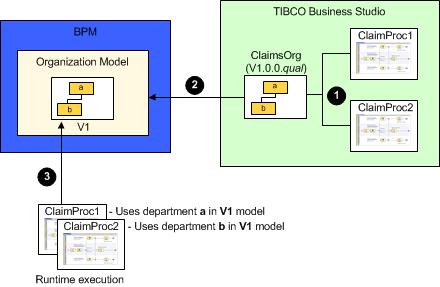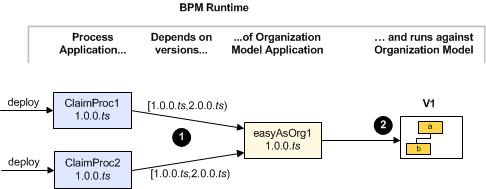Example - Phase 1 Deploying an Initial Organization Model
EasyAs Insurance is rolling out an implementation of a new application, starting with the Customer Services division.
The initial implementation defines two applications:
Design Time
The solution designer:
(1) Produces V1.0.0.qual of the ClaimsOrg organization model (in its own project).
(2) Adds participants from department a to ClaimProc1, and from department b to ClaimProc2. Each participant is defined as an external reference to the ClaimsOrg organization model.
ClaimsOrg’s major version number (1) is recorded (internally) in the ClaimProc1 and ClaimProc2 process definitions as part of the participant definitions.
Deployment
The solution designer:
(1) Deploys the ClaimsOrg organization model as the easyAsOrg1 application, version 1.0.0.ts.
(2) Deploys the ClaimProc1 and ClaimProc2 projects as the correspondingly named applications, version 1.0.0.ts.
Runtime
As the deployed ClaimsOrg organization model has a new major version number, TIBCO ActiveMatrix BPM creates it as a new runtime organization model.
Directory Services uses the deployment artifact from the 1.0.0.ts version of the easyAsOrg1 application to create a new V1 organization model.
User Application Dependencies
- Min is the version referenced when the process application is initially deployed. The square bracket denotes that the value is inclusive.
- Max is the next major version. The round bracket denotes that the value is exclusive.
For example, [1.0.0.ts,2.0.0.ts) denotes any version from 1.0.0.ts (inclusive) to 2.0.0.ts (exclusive). (The ts is not used in the comparison.)
ClaimProc1 and ClaimProc2 both:
(1) have a dependency on the easyAsOrg1 application, version 1.0.0.ts (inclusive) to version 2.0.0.ts (exclusive).
(2) execute against V1 of the runtime organization model.



